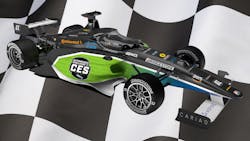New World Autonomous-Racing Speed Record Set at CES 2023
This article appeared in Electronic Design and has been published here with permission.
Read more articles in our CES 2023 coverage
At CES 2023, the Indy Autonomous Challenge (IAC) showcased its AV-21 autonomous race car at the Las Vegas Motor Speedway. Overall, nine teams participated in the race, hoping to set new autonomous racing records. The IAC competition involves a single elimination tournament with multiple rounds of high-speed head-to-head passing matches with the race cars, ending in a championship round.
Global universities programmed these autonomous racing cars with open-source hardware, including ROS 2 (Robot Operating System). Generally, ROS 2 is applied in other robotic systems; it can present some challenges for autonomous cars. That’s why Apex.AI built a ROS 2 version that meets the requirements for a successful run. It generally features ROS 2 and ROS middleware improvements that meet performance requirements for the IAC.
Initially, teams participating in IAC used commercial software and a commercial DDS. Then, they switched over to ROS 2 with the Eclipse Cyclone DDS.
Last year, the top two CES teams used the latest ROS 2 Galactic featuring the Eclipse Cyclone with the iceoryx zero-copy (developed by Apex.AI). In that race, TUM passed PoliMOVE and reached 165 miles per hour. Then, PoliMOVE prepared the attack on the next lap, reaching 168, 169, and 170 until hitting 173 mph.
A few weeks earlier, PoliMOVE brought its vehicle to Apple’s five-mile high-speed oval in the Yucca Flats south of Kingman, Arizona. Its autonomous car reached 176 mph with 100% open-source software.
CES attendants were treated with the Dallara AV-21 race cars alternating between the leader (defender) and passer/follower (attacker) roles. Each car attempted passes at higher speeds until one or both vehicles could no longer complete a pass. According to IAC competition rules, each team needed to qualify in a high-speed autonomous time trial, which determined their seed in the head-to-head passing competition. This past Saturday, six of the nine teams raced in a head-to-head competition.
PoliMOVE from Politecnico di Milano (Italy) and the University of Alabama won the racing challenge, reaching 180 mph, a new world record for autonomous racing. PoliMOVE competed against nine teams from 17 universities spanning six countries aiming to break autonomous-racing records. The German team (TUM Autonomous Motorsport from Technische Universitat Munchen) won second place. Other teams included AI Racing Tech, Autonomous Tiger Racing, Black & Gold Racing, Cavalier Autonomous Racing, KAIST, MIT-PITT-RW, and TII EuroRacing.
Read more articles in our CES 2023 coverage
About the Author
Cabe Atwell
Engineer, Machinist, Maker, Writer. A graduate Electrical Engineer actively plying his expertise in the industry and at his company, Gunhead. When not designing/building, he creates a steady torrent of projects and content in the media world. Many of his projects and articles are online at element14 & SolidSmack, industry-focused work at EETimes & EDN, and offbeat articles at Make Magazine. Currently, you can find him hosting webinars and contributing to Penton’s Electronic Design and Machine Design.

